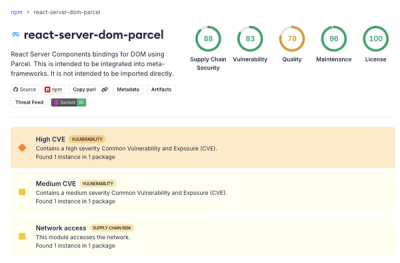
Security News
Deno 2.6 + Socket: Supply Chain Defense In Your CLI
Deno 2.6 introduces deno audit with a new --socket flag that plugs directly into Socket to bring supply chain security checks into the Deno CLI.
browser-refresh
Advanced tools
Node.js module to enable server updates and restart and browser refresh in response to file modifications
This module improves productivity by enabling instant web page refreshes anytime a front-end resource is modified on the server. This module supports live reloading of CSS and JavaScript without doing a full page refresh. This module utilizes the very efficient chokidar module for watching for changes to the file system. Web sockets are used to communicate with the browser. Minimal application code changes are required to benefit from this module.
Like nodemon, this module provides a drop-in replacement for the node command.
Compared to nodemon, the browser-refresh module has the following benefits:
browser-refresh.browser-refresh-ignore file (same format as .gitignore and .npmignore).browser-refresh client if the application was launched using browser-refresh. Please see: browser-refresh-taglibbrowser-refresh process waits for the child process to tell it that it is ready to start serving traffic so that the web browser page is not refreshed too soon. This is done by the child process using process.send('online')File patterns to ignore are automatically loaded from the first file that exists in the following list:
.browser-refresh-ignore file in the current working directory.gitignore file in the current working directoryIf no ignore file is found then the following ignore file patterns are used:
node_modules/
static/
.cache/
.*
*.marko.js
*.dust.js
*.coffee.js
NOTE:
Patterns to ignore files with a directory should have / at the end.
For example, to ignore node_modules directory use node_modules/.
First, install the global command line interface for the browser-refresh module:
npm install browser-refresh -g
Add the following code snippet to the appropriate location based on when your application is ready to start serving traffic:
if (process.send) {
process.send('online');
}
For example:
app.listen(port, function() {
console.log('Listening on port %d', port);
if (process.send) {
process.send('online');
}
});
Alternatively, pass an object that specifies a url for browser-refresh to launch the first time your app starts:
if (process.send) {
process.send({ event:'online', url:'http://localhost:8080/' });
}
Finally, add the following script to your page(s). Just before the closing </body> tag is a good place.
'<script src="{process.env.BROWSER_REFRESH_URL}"></script>'
When
browser-refreshlaunches your app a newBROWSER_REFRESH_URLenvironment variable is added with the URL that should be used to include the client-side script. The value ofBROWSER_REFRESH_URLwill be similar tohttp://localhost:12345/browser-refresh.js(the port is random). You should use whatever means your templating language or UI library provides to add the script to your page(s).
If you're using Marko, checkout browser-refresh-taglib which allows you to simply drop the following tag into your template instead of using the above <script> tag:
<browser-refresh/>
Some of the features of the browser-refresh module can be configured by creating
a .browser-refresh JSON configuration file at the root of your project.
To enable SSL support you must provide values sslCert and sslKey
in your .browser-refresh configuration file.
sslCert: The path to a SSL certificatesslKey: The path to a SSL keyExample:
{
"sslCert": "server.crt",
"sslKey": "server.key"
}
Once you have installed browser-refresh using the directions provided above, you can then start your application as normal, except replace node with browser-refresh. For example:
# Old: node server.js
# New:
browser-refresh server.js
If the main property is configured correctly in your application's package.json then you can simply start your application using the following command:
browser-refresh
The browser-refresh command will pass all command line arguments to the child process. Therefore, you can pass any number of arguments to your application:
browser-refresh server.js --foo --bar
After launching your application using the browser-refresh command, you can then load any web page as normal. If the <browser-refresh> tag (or {@browser-refresh/} helper) were used then any time a resoure is modified then the application will be restarted and, then, when the server is ready a message will be sent to all of the connected browsers via a web socket connection to trigger a reload of the same web page.
By default, this module does not try to be clever when handling a file modification. That is, by default, a full server restart and a full web page refresh are used whenever any type of file is modified on the server. This ensures that the server state and the client-side page state will always be correct and avoids frustrating edge cases. However, the browser-refresh module allows for modules to register "special reload" handlers that can short-circuit a full server restart. To disable a full server restart for a particular file pattern, the child process needs to send a message to the browser-refresh launcher process using the browser-refresh-client module.
For example, to enable special reloading, the following code can be used:
require('browser-refresh-client')
.enableSpecialReload('*.foo *.bar')
.onFileModified(function(path) {
// Handle the modification of either a *.foo file or
// a *.bar file...
});
Both the marko and lasso modules provide support for enabling special reload handlers when using the browser-refresh module. Example usage:
require('marko/browser-refresh').enable();
require('lasso/browser-refresh').enable('*.marko *.css *.less *.styl *.scss *.sass *.png *.jpeg *.jpg *.gif *.webp *.svg');
To add your own special reload handlers for the browser-refresh module, please use the following code as a guide:
For improved developer productivity, this module supports refreshing of CSS and images without doing a full page refresh (similar to LiveReload). This is an opt-in feature that can be enabled using code similar to the following:
var patterns = '*.css *.less *.styl *.scss *.sass *.png *.jpeg *.jpg *.gif *.webp *.svg';
require('browser-refresh-client')
.enableSpecialReload(patterns, { autoRefresh: false })
.onFileModified(function(path) {
// Code to handle the file modification goes here.
// Now trigger a refresh when we are ready:
if (isImage(path)) {
browserRefreshClient.refreshImages();
} else if (isStyle(path)) {
browserRefreshClient.refreshStyles();
} else {
browserRefreshClient.refreshPage();
}
});
If you are using require('lasso/browser-refresh').enable(patterns), it is doing this for you automatically. Please see: lasso/browser-refresh/index.js
nodeAny flags (arguments that start with -) before the script path will be passed to the node executable:
browser-refresh --debug index.js
Pull requests, bug reports and feature requests welcome.
ISC
FAQs
Node.js module to enable server updates and restart and browser refresh in response to file modifications
The npm package browser-refresh receives a total of 2,930 weekly downloads. As such, browser-refresh popularity was classified as popular.
We found that browser-refresh demonstrated a not healthy version release cadence and project activity because the last version was released a year ago. It has 4 open source maintainers collaborating on the project.
Did you know?

Socket for GitHub automatically highlights issues in each pull request and monitors the health of all your open source dependencies. Discover the contents of your packages and block harmful activity before you install or update your dependencies.

Security News
Deno 2.6 introduces deno audit with a new --socket flag that plugs directly into Socket to bring supply chain security checks into the Deno CLI.

Security News
New DoS and source code exposure bugs in React Server Components and Next.js: what’s affected and how to update safely.

Security News
Socket CEO Feross Aboukhadijeh joins Software Engineering Daily to discuss modern software supply chain attacks and rising AI-driven security risks.